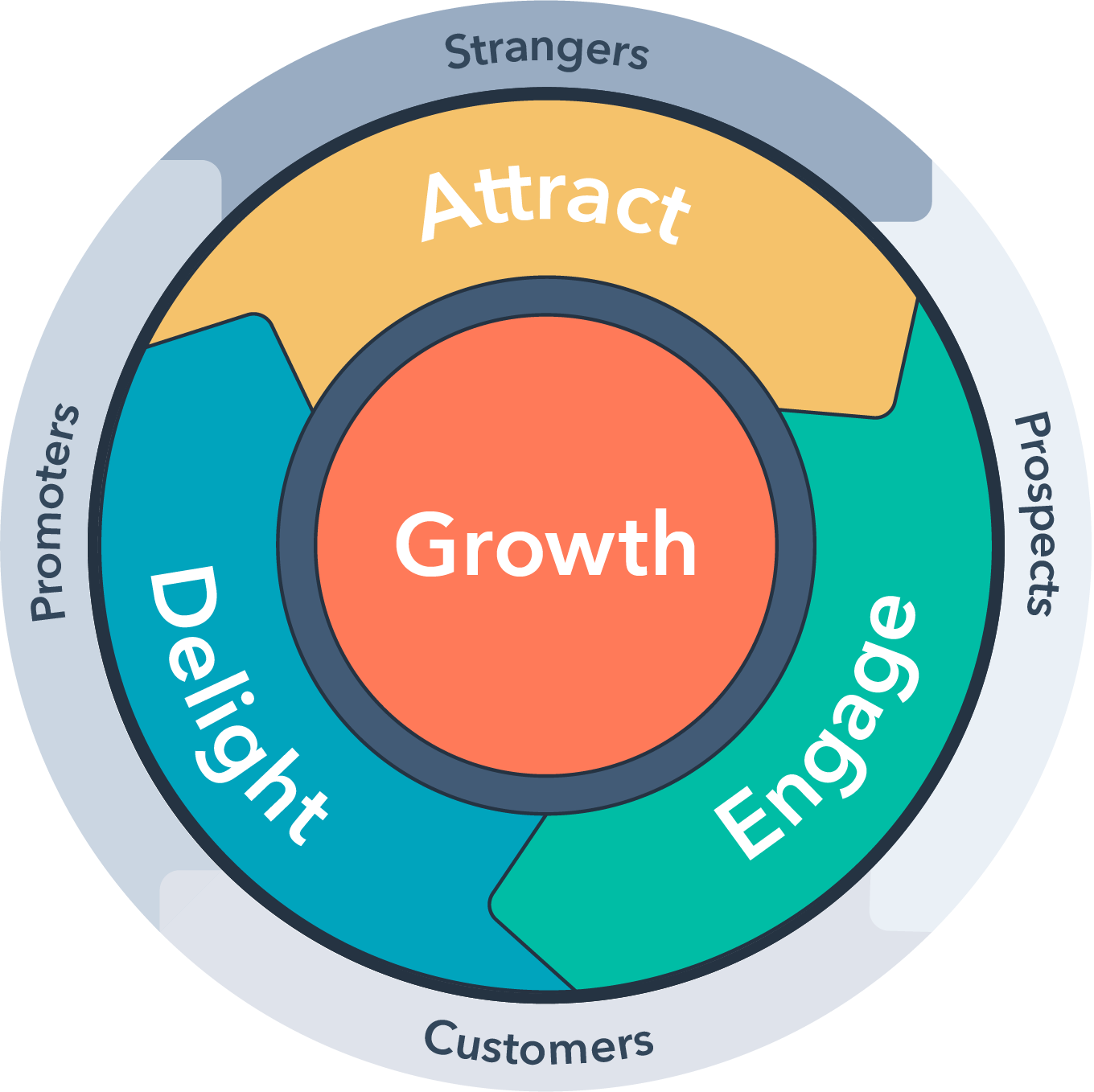Unlocking Sustainable Growth: Why the Hubspot Flywheel Model Outshines the Traditional Sales Funnel.
Remember the spinning tops of your childhood? These simple toys, when set in motion, would spin and spin until they gradually slowed down and eventually toppled over. But what if there was a spinning top that never stopped?
Imagine a child’s delight when they came across a top that, once spun, seemed to defy the laws of physics. It continued to spin with undying energy, creating a sense of wonder. Just as the child’s spinning top kept going, so does the flywheel model in marketing.
We’re all familiar with the traditional ‘sales funnel’. If you’ve been anywhere near a sales and marketing team in the past couple of decades, you’ll know the sales funnel has been used endlessly to inform strategy and help plan and structure the journey from prospect to lead and eventually, to customer.
However, the evolution of the sales and marketing industries and ever increasing customer expectations mean that the traditional funnel is no longer fit for purpose.
The problem with the sales funnel
The traditional sales funnel has several shortcomings that have become increasingly apparent in the modern business landscape. Some of the key problems with the traditional sales funnel include:
- Linear Structure: The traditional sales funnel is linear, with distinct stages that include awareness, consideration, and decision. This linear approach doesn’t reflect the complexity of the modern customer journey, where prospects often engage with a brand across various touchpoints in a non-linear fashion.
- Neglects Post-Purchase: Once a customer reaches the bottom of the funnel and makes a purchase, the funnel model often neglects what happens post-purchase. This lack of emphasis on the post-purchase phase can result in lost opportunities to retain customers, build loyalty, and encourage them to advocate for the brand.
- One-Way Process: The funnel primarily focuses on pushing prospects down the funnel to make a purchase, like a conveyor belt, but it may not adequately consider the importance of creating a positive customer experience or nurturing ongoing relationships. This can lead to a transactional approach that misses the opportunity for long-term customer value.
- Customer-Centricity: The funnel doesn’t prioritise the customer’s needs and experiences throughout the entire journey. It tends to be more business-centric, with an emphasis on converting leads into customers, often overlooking the customer’s perspective.
- Lack of Advocacy: The funnel model doesn’t inherently promote or harness customer advocacy. Satisfied customers are not always encouraged to become brand advocates or to share their positive experiences with others, missing out on a valuable source of word-of-mouth marketing.
- External Factors: The funnel model often doesn’t account for external factors that can influence a prospect’s decision-making process, such as the abundance of marketing messages, advertising, and competing distractions in the modern digital landscape.
- Loss of Momentum: Leads may lose momentum as they progress through the funnel, and there’s often no mechanism to harness that lost energy to drive future growth. This loss of momentum can be detrimental to long-term business success.
Stats from the Semrush blog highlight the dangers of some of these limitations, stating that, ‘90% of people are much more likely to trust a recommended brand (even from strangers) and 26% of people will completely avoid a brand if their friend or family tells a negative story about their experience.’
Syed Balki also articulates the limitations of the funnel in an article for Entreprenuer.com ‘Funnels lose energy by the time a lead reaches the bottom. You’ve completely lost any momentum it gained as it moved through the funnel, and there’s no way to harness it to drive future growth. Meanwhile, you’re busy using up energy to generate new leads every month.’
In a nutshell, the linear structure of the traditional funnel model doesn’t reflect the modern customer journey, and it does it allow for the integrated and intelligent inbound marketing strategies that offer excellent customer experience and facilitate growth over time.
What is a Hubspot flywheel?
Time for a little bit of history. The flywheel was invented by James Watt over 200 years ago to power his steam engine during the Industrial Revolution. It is incredibly energy efficient at capturing, storing, and then releasing energy. The amount of energy it stores depends on how fast it spins, how much friction there is to counteract that spinning motion, and the composition of the wheel itself.
HubSpot however, takes the credit for recognising the limitations of the traditional funnel and applying Watt’s very industrial flywheel concept to inbound marketing methodology, in particular how this stored ‘energy’ can be applied and maintained to help businesses grow. Michael Redbord explains the funnel to flywheel transition in more detail in this HubSpot article.
HubSpot’s description of the flywheel states, ‘With the flywheel, you use the momentum of your happy customers to drive referrals and repeat sales. Basically, your business keeps spinning.’
Put simply, it’s a case of a force or combination of forces creating a momentum or energy that then self sustains the ongoing movement of the flywheel. Any friction that enters the equation will slow this movement down.
Let’s put the theory into practice. Businesses will apply force to their flywheel such as inbound marketing, referral programmes, paid advertising and an excellent customer service team. All of these things will enhance customer experience and, hopefully, lead them to promote their experience to others and purchase again. These repeat purchases and advocacy generate sales, keeping the flywheel spinning. Friction, such as poor internal processes, inadequate customer support, confusing messaging or complicated purchasing journeys will reduce the number of these repeat purchases and recommendations, slowing the flywheel (and growth) down.
Syed Balki explains in an article for Entreprenuer.com, that a flywheel, ‘leverages the momentum of every lead and customer to keep spinning throughout the customer journey. It does such a good job of preserving momentum that you only need to give small pushes to keep it moving and grow your business.’
Compared to the funnel, the inbound marketing flywheel is a much more organic and cyclical ecosystem, that with the right strategy and maintenance, can generate its own leads and sales through positive customer experience.
Growth is at the core of the flywheel – here’s why
The flywheel is a model that any business serious about growth should consider structuring its inbound marketing around.
When applied to inbound marketing, the flywheel model allows customers to add energy and ‘make it spin’. Happy customers provide the energy either through repeat purchase or referral and recommendation. Unhappy customers provide friction and affect overall momentum. You can see why customers take centre stage in the model!
Therefore, everything a business does should be focused on the goal of creating and maintaining happy customers who will keep adding energy to the flywheel, and reducing spots of friction that may slow this momentum down. This includes inbound marketing techniques to internal communications between teams.
Unlike the funnel model, which relies on significant investment in constantly getting new prospects into the top of a funnel to grow, businesses that adopt the flywheel model are effectively investing in the ‘energy’ of each and every satisfied customer to grow their business and keep that flywheel spinning. The flywheel model uses customers as the driving force behind business growth.
The three phases of the flywheel
There are three phases of the inbound marketing flywheel. Let’s take a look.
- Attract
The first stage of the traditional funnel model is ‘awareness’, whereby companies invest in going out to potential customers to build awareness of them and their product. The first stage of the flywheel model is ‘attract’ which flips this concept on its head. Instead of using outbound marketing techniques, the flywheel puts the emphasis on attracting or ‘pulling’ customers to a business through relevant content on existing channels.
During this phase, businesses should recognise a consumer need or challenge and draw attention to the solution that their product or service provides. Businesses need to add value to their potential customers’ lives by helping them overcome an issue, meeting a need or providing educational information.
By creating relevant content such as blog articles, content offers, ‘how to’ guides or utilising paid channels such as PPC or social media, companies can provide valuable and relevant information to potential customers as an introduction to their brand or product.
Optimising this content with an SEO strategy will further strengthen the ‘pull’ or how effectively a business attracts clients to their content. By targeting specific key words and phrases related to a product or service, the content that aims to ‘attract’ will organically appear on the search engine results page and meet the needs of the people who are searching for this information — the target audience.
- Engage
Engagement within the flywheel model has replaced the ‘consideration’ stage of the funnel model. At this point businesses should look to build on the relationship started during the ‘attract’ phase.
Companies are likely to have some data on potential customers at this stage, either through captured email addresses, website cookies or social media interactions. Businesses now have a captive audience and a selection of channels to engage with these potential customers, in a dynamic, personalised and relevant way.
Email marketing and organic social media strategies are just some useful tools to implement at this stage to really showcase a business’ values and personality and nurture that all important relationship. The content shared at this stage will help cement in prospect’s minds that a business or product is the one for them. Top tips, free webinars, testimonials, exclusive content and product showcases are all pieces of content that will help do this.
- Delight
Inbound strategies that ‘delight’ (replacing, the ‘decision’ stage of the funnel model), ensure customers are happy, satisfied, and supported during every stage of the purchasing process and beyond.
Briand Halligan, co-founder and CEO of HubSpot explains in The Harvard Business Review that ‘Now, delighted customers are the biggest new driver of growth’.
At this stage businesses should focus on how they can delight customers, not only through the product or service they provide, but with brilliant customer service and continued value offered through ongoing marketing.
Effective chatbots, a seamless purchase journey and easy to access real time and after sales support are just some ways businesses can provide a positive customer experience here.
Unlike the funnel model, with the flywheel, positive customer experience doesn’t end after the purchase. Loyalty campaigns for existing customers that encourage repeat sales or referrals are really effective, as is exclusive content, discounts or sneak peaks at upcoming products.
How to build your flywheel?
Building a flywheel in your business involves a strategic approach that focuses on creating a positive customer experience and harnessing customer momentum to drive growth.
Here are the steps to build your flywheel:
-
Understand the Customer Journey
Begin by understanding the entire customer journey, from the first touchpoint to post-purchase interactions. Identify key touchpoints and stages in the customer’s experience with your brand.
-
Identify Customer Needs:
Recognise the needs, challenges, and pain points of your customers at each stage of their journey. What problems can your product or service solve for them?
-
Create Valuable Content
Develop high-quality, customer-centric content tailored to each stage of the journey. This content should provide value, educate, and engage customers. Include blog articles, guides, videos, and other relevant materials.
-
Optimise for Customer Experience
Ensure a seamless and positive customer experience throughout their journey. This includes providing excellent customer service, easy navigation, and user-friendly interfaces.
-
Attract New Customers
At the “Attract” phase, use inbound marketing strategies to pull potential customers to your brand. This may include creating informative blog content, using paid advertising, and engaging on social media.
-
Engage Prospective Customers
During the “Engage” phase, focus on building and nurturing relationships with prospects. Provide personalized and valuable content, including email marketing, webinars, testimonials, and exclusive offers.
-
Delight Existing Customers
In the “Delight” phase, go above and beyond to ensure existing customers have a positive experience. Offer outstanding customer support, provide useful product tips, and engage them with exclusive content and loyalty programs.
-
Integrate CRM and Teams
Ensure seamless collaboration between your sales, marketing, and service teams through a Customer Relationship Management (CRM) system. This alignment helps provide a holistic customer experience.
-
Monitor and Analyse
Continuously monitor and analyse customer interactions and feedback. Use data to understand what’s working and what needs improvement. Tools like analytics and customer feedback loops are valuable.
-
Encourage Advocacy
Encourage happy customers to become advocates for your brand. This can involve referral programs, reviews, and encouraging them to share their positive experiences with others.
-
Maintain Momentum
Focus on maintaining the momentum of your flywheel. Ensure that your customers keep adding energy to it by continually engaging and delighting them. This can lead to sustained growth and more advocates.
-
Internal Alignment
Align your internal processes and teams to support the flywheel model. Ensure that everyone in your organisation understands the importance of customer satisfaction and growth through advocacy.
-
Scale and Adapt
As your flywheel gains momentum, be prepared to scale and adapt your strategies. The more satisfied customers you have, the more they’ll advocate for your brand and help it grow.
Building a flywheel is an ongoing process that involves customer-centricity and a focus on creating a positive customer experience at every stage. By attracting, engaging, and delighting your customers, you can keep the flywheel spinning and drive sustainable growth for your business.
In conclusion…
We hope this article has provided some clarity over the differences between the traditional funnel model and the flywheel model, as well as highlighting the significant growth opportunities the inbound marketing flywheel model offers, if executed well.
Dr Josh Axe for Leaders.com, explains, ‘Ultimately, the difference between a funnel and flywheel is one drains leads into buyers, while the other uses the customer experience as a source of power. By shifting the core focus to attracting, engaging, and delighting people, flywheels open up the opportunity for a constant stream of customer acquisition. This is what leads companies toward creating the conditions for perpetual growth.’
At Media Matters, we live and breathe measurable, inbound marketing strategies and believe that the best leads are the ones that come to you and your business. As a certified HubSpot Solutions Partner, we have a wealth of experience supporting our clients with their inbound marketing strategies that attract, engage and delight customers.
Get in touch today, and let’s see how inbound marketing and Hubspot flywheel marketing strategies can help grow your business.





